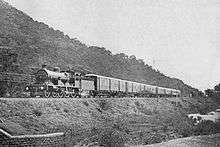Mumbai–Pune Mail
Mumbai-Pune Mail (started as Bombay-Poona Mail) or Poona Mail was a luxurious train on Mumbai-Pune section by the Great Indian Peninsula Railway. It was the first intercity train started between Mumbai and Pune. This train and the famous Deccan Queen Express used to serve Mumbai Pune commuters for many years. Later this train was extended to Kolhapur from 11 November 1971 and was renamed Sahyadri Express.[3] This train was believed to carry Royal Mail and was one of the finest trains in British Empire.[4]
 Poona Mail (ca. 1907) | |||||
| Overview | |||||
|---|---|---|---|---|---|
| Service type | Mail Train | ||||
| Locale | Bombay Presidency, British India | ||||
| First service | 1869 [1] | ||||
| Last service | 1971 | ||||
| Current operator(s) | Great Indian Peninsula Railway | ||||
| Route | |||||
| Start | Victoria Terminus, Mumbai | ||||
| End | Pune Junction | ||||
| Distance travelled | 192.2 km (119.4 mi)[2] | ||||
| Average journey time | 4 hours, 15 minutes | ||||
| Service frequency | Daily | ||||
| On-board services | |||||
| Class(es) | First Class, Second Class and Intermidate Class | ||||
| Seating arrangements | Yes | ||||
| Sleeping arrangements | No | ||||
| Technical | |||||
| Track gauge | 1,676 mm (5 ft 6 in) | ||||
| Operating speed | 45.81 km/h (28 mph) with stops | ||||
| |||||
Timetable
It used to leave Pune at 7 am and Lonavala at 8:15 am and reach Mumbai by 11:10 am. The return train used to leave Mumbai at 2:45 pm and Lonavala at 5:55 pm and reach Pune by 7 pm.[5] Later the departure time was changed to 5:55 pm from Mumbai.[3]
Coaches and Operation 1907
Coaches
In the year 1907 the train was operated with seven coaches with a total weight of 240 t. Seats for 50 first, 95 second and 320 third class passengers were provided. The restaurant car had another 32 seats. The train crew of 8 man included guard, conductor, car attendant, refreshment manager and waiters. The livery of the train was dark red-brown on the lower part and cream for the upper part.[2]
Each car was 62 ft (19 m) long and 10 ft (3 m) wide. The chairs could be turned around in order that the passengers were always looking in the travel direction. The cars had electric lighting powered by axle driven generators. 3rd class passengers did not have reserved seats. Punkah fans were provided only in 1st and 2nd class. The cars were fitted with vacuum brake and passenger alarm signal.[2]
Train Composition
The train was composed in the following way:
- Locomotive
- Combination car with baggage compartment, guard compartment, 3rd class seating with compartments for Indian women and 3rd class refreshment bar
- 3rd class chair car
- 2nd class car with chair seating as well as two compartments and a cloakroom
- Composite car containing 1st and 2nd chair class and 1st class compartments
- Dining car
- 1st class parlor car with smoking room and ladies's boudoir
- Combination car with baggage, post office and guard facilities and 3rd class chair compartment for Europeans.[2]
Traction
The train was pulled by a 4-6-0 steam engine from Mumbai to the beginning of the 1:37 inclined Bhor Ghat ramp. There the power was changed to two 0-4-0T engines, which brought the train up the ramp. In Lonavla the power was changed again to one single 4-coupled engine for the rest of the 119 mi (192 km) long journey to Pune.[2]
See Also
- Mumbai-Pune Passenger
- Sister trains Mumbai-Pune:
- Via Kalyan
- Deccan Express
- Deccan Queen
- Indrayani Express
- Intercity Express
- Sinhagad Express
- Via Panvel
- Defunct
- Mumbai-Pune Shatabdi Express
References
- The oldest fast trains in India, and other topics for fans of the Indian Railways
- Bombay–Poona Mail. Railway and locomotive engineering : a practical journal of railway motive power and rolling stock. Vol. 20. New York: A. Sinclair Co. 1907. pp. 481–482.
- "Classic Trains of India". IRFCA. Archived from the original on 28 November 2006. Retrieved 1 May 2016.
- "Bombay-Poona Mail. Great Indian Peninsular Railway-". www.imagesofasia.com. Retrieved 1 May 2016.
- "1918 GIPR Timetable". IRFCA. Retrieved 1 May 2016.
_Express_trains_route_map.png)